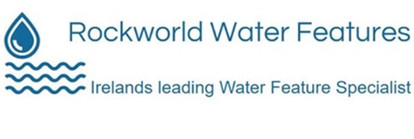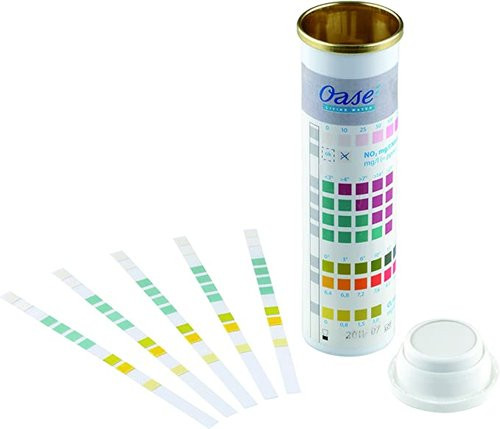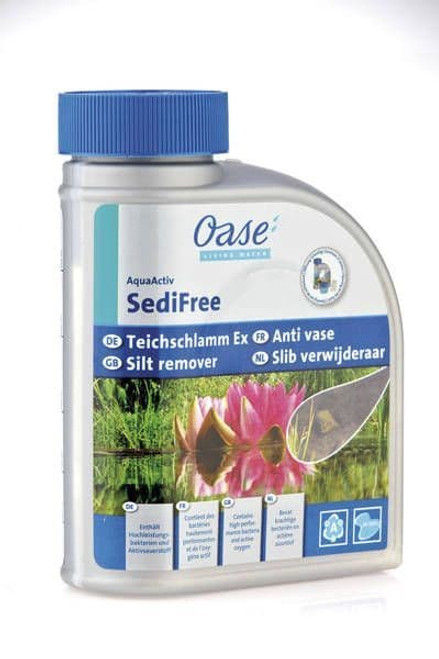Description
Oase AquaActive Quicksticks 6in1
Oase Quickstick 6 in 1 is the new quick test kit from Oase.
The Quickstick tests for pH value, total hardness, carbonate hardness, nitrite (NO2), nitrate (NO3), chlorine (CL2). Simply dip the strip in to pond water and compare against the handy chart on the container. It really couldn't be easier and as the kit contains over 50 strips, you can be confident of accurate, reliable results for longer.
Instructions:
Dip the test strip in the pond water for one second.
Shake off excess water
Wait for one minute then compare against colour chart
Key Features:
For fast, simple and reliable water analysis for the 6 most important values. Takes about one minute. Suitable for testing approximately 50 water samples (300 parameters).
AquaActiv Quickstick 6in1
Water quality is the crucial factor for the biological balance and the health
of your pond fish. Consequently,from time to time it is necessary to
check the water values and take corrective measures if necessary. With
AquaActiv Quickstick 6in1 you have the possibility of easily checking the six most important water values.
Dip a test strip for 1 second into the water that will be checked. Briefly
shake off the strip and wait for approximately 1 minute. Then compare
the colour fields on the strip with the colour scales.
Unfortunately, these days tap water is not always suitable for fi sh and
plants. For example, excessive nitrate or chlorine values in tap water
are no longer rarities. Thus from time to time you should also check your
tap water that you use to fill your pond.
Please note:
- Store the test strips in their box and only take out as many strips as
you need. The test strips are sensitive and react to humidity. The cap
contains a desiccant that absorbs the humidity. Always close the cap
immediately after taking out a strip. The test fields of the test strips are
„fish-compatible“. You can dip the strips directly into your garden pond.
- Do not touch the test fields with your fingers
- Do not take the measurement under flowing water.
- If you take a water sample from your garden pond for analysis, use
a clean container without residues of dishwashing detergent or similar
substances. Always fill the sample container completely full. If the container is only partially full the water values can change. Completely immerse the container and seal it under water.
- Keep it out of the reach of children!
Chlorine (CL2):
Some water supply utility companies add chlorine to tap water for disinfection. Even in extremely low quantities chlorine is intolerable for pond
fish and other pond inhabitants and must be removed from the water before the water is added to the pond. The chlorine test field should be light
yellow and thus show a value of „0”. You can quickly and conveniently
eliminate chlorine with the Oase Safe&Care pond treatment.
pH value:
The pH value indicates the degree of acidity of the water. A pH value of 7 is
neutral. pH values below 7 are acidic and pH values above 7 are referred
to as alkaline. The pH value is a value to the 10th power. If the pH value
changes by one unit this means a 10-fold change.
Determine the pH value of your water by comparing the pH measurement
field of the test strip with the corresponding colour scale on the label of the box. A transitional colour indicates an intermediate value.
The optimal pH value for your pond should be between 6.8 and 8.0. If
you want to change the pH value, you should always proceed very
carefully to avoid large pH jumps. To lower pH values that are too high we
recommend using AquaActiv AquaHumin. You achieve long-term stabilisation of the pH value with pondoptimised AquaActiv OptiPond.
Total hardness (GH):
To determine Total hardness the calcium and magnesium salts dissolved
in water are measured. Most pond fish do well in medium-hard water
(10 - 15 °dGH). Compare the 4 GH test fields on the test strip with the scale on the label of the box. The number of violet coloured test fields shows the total hardness. If a test field is only partially violet-coloured, this indicates
an intermediate value. We recommend the use of AquaActiv AquaHumin to reduce hardness. An increase in hardness can be achieved with pond-optimised AquaActiv OptiPond.
Carbonate hardness (CH):
Carbonate hardness indicates the pH buffer capacity of the water. It
stabilises the pH value. Thus at low carbonate hardness the pH value is
unstable and can change erratically. Optimal carbonate hardness for garden ponds is 5 - 8 °dcH. Determine the carbonate hardness of your water by comparing the CH measurement field of the test strip with the corresponding colour scale on the label of the box. A transitional colour indicates an intermediate value.
We recommend the use of AquaActiv AquaHumin to reduce hardness.
An increase in hardness can be achieved with AquaActiv OptiPond.
The nitrogen compounds, nitrite (NO2) and nitrate (NO3):
Decomposition of organic nitrogen compounds of fish waste, remains of
dead plants, fish food remnants, etc. occurs in several stages.
1. Ammonia and ammonium occur from organic wastes. Ammonium is
absorbed by water plants as nitrogen fertiliser, ammonia on the other hand
is highly toxic. Conversion of ammonia or ammonium depends on the
pH value. At low pH values <7 ammonium occurs. At high pH values
ammonia increasingly occurs.
2. From ammonium/ammonia nitrite occurs, which is toxic for fish.
3. Nitrite is converted into nitrate. Nitrate is only toxic in high concentrations and is absorbed as a nutrient by water plants.
The individual decomposition stages are generated by microorganisms
that form in the filter and on the floor of the pond and together with
other microscopic creatures form a complex life unit. Increased nitrite
or nitrate values are indicators that the biological balance in your pond is
not in order. In this case you should replace the water in your pond and
identify the causes. To create and maintain a high-performance culture
for microorganisms we recommend using AquaActiv BioKick fresh.
Even in extremely low concentrations, nitrite is intolerable for fi sh. If
you determine a discolouration on the nitrite warning field, you should
intervene. Replace the pond water immediately and add highly-active
AquaActiv BioKick fresh fresh water bacteria and AquaActiv OxyPlus
to supply oxygen.
Determine the nitrate content of your water by comparing the nitrate measurement field of the test strip with the corresponding colour scale on the
label of the box. A transitional colour indicates an intermediate value.
As a rule, nitrate content should not exceed 50 mg/l. At values greater
than 100 mg/l immediate intervention is necessary (partial water change
with nitrate-free water). Water plants absorb nitrate as nutrients. You can
count on increased algae growth starting at 10mg/l.
Algae problems
If you have problems with increased algae growth, treatment should
be executed. First we recommend stabilising the water values with
AquaActiv OptiPond. Often it then suffices to bind excess nutrients with
AquaActiv PhosLess filter media tubes. In stubborn cases algae can
be directly eliminated with AquaActiv AlGo algae control. To achieve
long-term success you should decompose the nitrogen compounds in
the sediment with AquaActiv SediFree. In addition you should only
feed fish sparingly and use as






